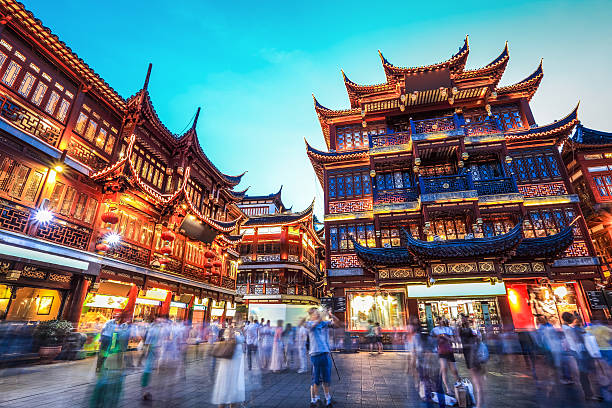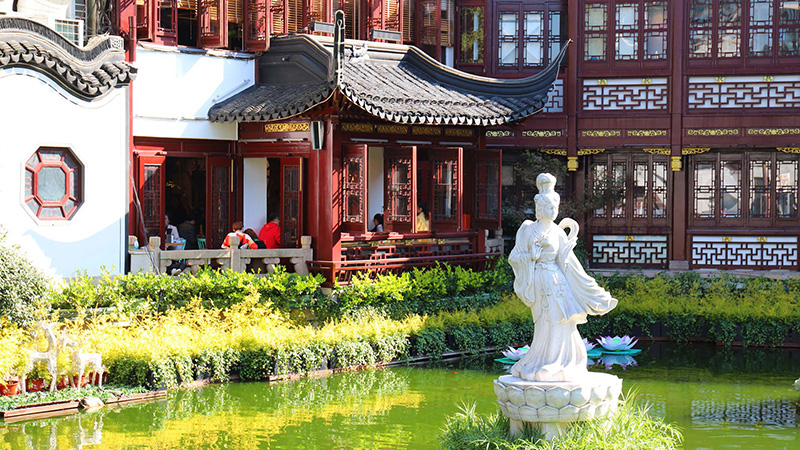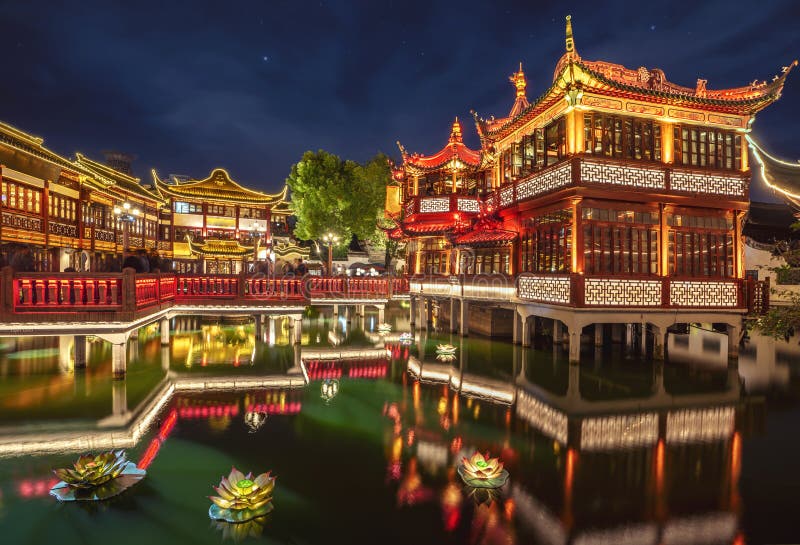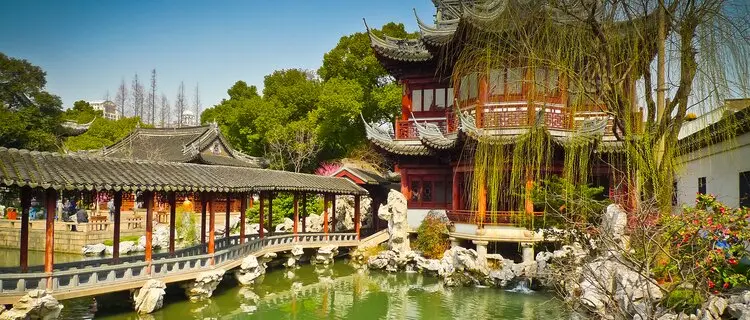Experience Serenity: The Benefits of Visiting Yu Garden in Shanghai
An Essential Guide to Visiting Yu Garden Shanghai
Nestled in the vibrant heart of Shanghai, Yu Garden (上海豫园) stands as a serene oasis that effortlessly transports visitors back to the Ming Dynasty, over 400 years ago. This enchanting garden, a masterpiece of classical Chinese landscape design, is renowned for its stunning rockeries, tranquil ponds, and intricately detailed pavilions. What sets Yu Garden apart is its unique blend of natural beauty and historical significance, making it not only a visual delight but also a cultural treasure.
In this essential guide, we’ll explore the must-see highlights of Yu Garden, including the magnificent Grand Rockery and the famed Exquisite Jade Rock. You’ll discover practical tips for navigating the garden, the best times to visit, and how to make the most of your experience. We’ll also dive into the delightful culinary offerings nearby, perfect for those looking to indulge their taste buds after a day of exploration. Whether you’re a history buff, a photography enthusiast, or simply seeking a peaceful escape, this guide will help you uncover the magic of Yu Garden and ensure your visit is unforgettable.
In This Guide
- An Essential Guide to Visiting Yu Garden Shanghai
- The Rich History and Legends of Yu Garden Shanghai
- Main Highlights: What You Absolutely Can’t Miss
- Planning Your Visit: A Practical Guide
- Tickets: Prices, Booking, and Tips
- How to Get There: A Complete Transportation Guide
- Local Cuisine and Accommodation Nearby
- Frequently Asked Questions
- Final Thoughts on Your Trip
The Rich History and Legends of Yu Garden Shanghai
Nestled in the bustling heart of Shanghai, Yu Garden (Yu Yuan) is not just a place of serene beauty, but a living testament to the rich tapestry of Chinese history and culture. With its origins dating back over 400 years, the garden offers visitors a glimpse into the artistry and philosophy that shaped Ming Dynasty China.
The Founding of Yu Garden
Yu Garden was established during the Ming Dynasty in the 16th century by Pan Yunduan, a successful scholar-official. The garden was designed as a tranquil retreat for his father, who longed for peace and relaxation in his old age. The name “Yu,” meaning peace and joy, reflects both the garden’s purpose and the philosophy of harmony that characterizes traditional Chinese landscape design.
As visitors stroll through the garden today, they can appreciate Pan Yunduan’s vision, which beautifully fuses natural and architectural elements. The layout includes winding paths, serene ponds, and exquisite pavilions, all meticulously crafted to create a harmonious environment.
Key Historical Periods
Ming Dynasty (1368-1644)
The garden was constructed in the early years of the Ming Dynasty, a period marked by cultural flourishing and artistic innovation. Yu Garden flourished as a haven for scholars and poets, who gathered to reflect, write, and engage in philosophical discussions amidst the stunning landscapes.
Qing Dynasty (1644-1912)
During the Qing Dynasty, Yu Garden underwent significant expansions and renovations. It became a popular destination for local elites and emperors seeking respite from the demands of court life. The garden was enhanced with architectural features such as the Grand Rockery and the Exquisite Jade Rock, which remain highlights today.
Modern Era
Though the garden suffered neglect during the tumultuous years of the 20th century, efforts to restore and preserve it began in the 1950s. Today, Yu Garden stands as a cherished historical site, attracting millions of visitors from around the world and serving as a cultural hub in Shanghai.
Legends and Folklore
Yu Garden is steeped in legends that add to its mystique and charm. One famous tale speaks of the Exquisite Jade Rock, a remarkable stone that weighs around three tons and features holes that create a “fountain” effect. According to local lore, it was originally a gift to the garden from the Emperor of the Ming Dynasty, who believed it would bring good fortune to the area. Visitors often touch the rock for luck and prosperity.
Another enchanting story revolves around the Iron Lions that guard the garden. Cast during the Yuan Dynasty, these lions symbolize strength and protection. Legend has it that they come to life at night to protect the garden from malevolent spirits, ensuring that the peace and tranquility of Yu Garden remain undisturbed.
A Cultural Symbol
Yu Garden is much more than a beautiful landscape; it embodies the essence of Chinese culture and philosophical ideals. The intricate designs of the dragon walls, which separate different sections of the garden, represent the power and auspiciousness attributed to dragons in Chinese mythology. Each wall tells a story, weaving together art, nature, and history in a seamless narrative.
As modern Shanghai continues to evolve, Yu Garden remains a bastion of history, culture, and folklore. Its rich past, combined with engaging legends, offers international travelers a unique opportunity to connect with China’s heritage. Whether you are wandering through its tranquil pathways or marveling at its stunning architecture, Yu Garden invites you to embrace the peace and joy that it has symbolized for centuries.

Yu Garden Shanghai.
Main Highlights: What You Absolutely Can’t Miss
The Grand Rockery
The centerpiece of Yu Garden, the Grand Rockery is a marvel of Ming Dynasty artistry. Towering over visitors, this massive structure is composed of thousands of tons of yellow stone, intricately arranged to create a dramatic landscape. As you ascend to the Yangshan Hall platform, prepare to be awestruck by panoramic views of the garden below. Don’t rush your visit here; take your time to appreciate the craftsmanship and capture the stunning vistas!
Tip: Arrive early to avoid crowds, and consider visiting during the morning light for the best photography opportunities.
Exquisite Jade Rock
Weighing approximately three tons, the Exquisite Jade Rock is one of the “Three Famous Stones of Jiangnan” and a true testament to nature’s artistry. Its unique holes create a mesmerizing “fountain” effect, making it a captivating sight to behold. This rare Taihu stone not only captures the imagination but also embodies the historical significance of the garden.
Tip: Look for the small pond nearby, where the reflection of the rock adds an ethereal quality to your photos.
Dragon Walls
Adorned with colorful, intricate designs, the five dragon walls in Yu Garden are more than just decorative elements; they serve to separate different areas of the garden while enhancing its aesthetic appeal. These walls are a fantastic backdrop for photos, showcasing the artistry of traditional Chinese architecture.
Tip: Each wall features unique dragon motifs, so take a moment to admire the details. They are best viewed from the adjacent walkways, where you can truly appreciate their grandeur.
Iron Lions
Standing guard at the entrance of the garden, these iron lions date back to the Yuan Dynasty and symbolize power and prosperity. The male lion, with its paw resting on a globe, represents strength, while the female lion, cradling a cub, signifies nurturing. These majestic statues are perfect for a photo op, embodying the spirit of traditional Chinese culture.
Tip: Touch the lions for good luck, a tradition among visitors. Capture a photo with them to commemorate your visit!
Wan Hua Lou Windows
One of the garden’s hidden gems, the Wan Hua Lou features beautifully carved windows that depict the “Four Gentlemen”—plum, orchid, bamboo, and chrysanthemum. Each flower symbolizes a different season, making these windows not only a visual delight but also a representation of the harmony found in nature.
Tip: Position yourself at the right angle to capture the light filtering through the intricate carvings. This spot is particularly enchanting during the golden hour.
Ji Shi Lou
Often regarded as the garden’s most iconic structure, Ji Shi Lou is a stunning pavilion that offers a perfect vantage point for capturing the beauty of Yu Garden. Its layered roofs and elegant design reflect traditional Chinese architectural principles, making it a must-see for anyone interested in culture and history.
Tip: Head to the second floor for a less crowded view and a unique perspective of the surrounding landscape. This is also a great place to capture the glow of lanterns in the evening.
Yu Garden Bazaar
After soaking in the beauty of the garden, don’t miss the vibrant Yu Garden Bazaar, located just outside the garden entrance. This lively marketplace is filled with shops selling traditional handicrafts, souvenirs, and delicious street food. It’s a fantastic place to immerse yourself in local culture and perhaps pick up a unique keepsake to remember your visit.
Tip: Sample some Nanxiang steamed buns and browse the stalls for unique gifts. Plan your visit to include some time here, ideally after exploring the garden!
Yu Garden is a treasure trove of history, beauty, and culture waiting to be discovered. Each highlight offers a glimpse into the artistry and tradition of China, making your visit an unforgettable experience.

Yu Garden Shanghai.
Planning Your Visit: A Practical Guide
Best Time to Visit
Yu Garden is enchanting throughout the year, but each season offers a unique charm:
-
Spring (March to May): Witness the garden in full bloom with cherry blossoms and peonies. This is an ideal time for a peaceful stroll, as the weather is mild and the flowers are vibrant.
-
Summer (June to August): Experience the lively atmosphere filled with visitors. While the weather can be warm, early mornings or late afternoons are perfect for avoiding the crowds.
-
Autumn (September to November): With comfortable weather and stunning fall foliage, this season is perfect for photography. The colorful leaves create a picturesque backdrop.
-
Winter (December to February): Visit during the Lantern Festival around Chinese New Year for a magical experience filled with lights and festivities.
For a quieter experience, aim to visit on weekdays, especially in the morning between 9:00 AM and 10:00 AM.
Recommended Itinerary
To make the most of your visit to Yu Garden, consider this itinerary:
-
Arrival: Arrive at the Yu Garden Station on Metro Line 10 and exit at Exit 1.
-
Morning Exploration (1-1.5 hours): Begin your journey by exploring the garden’s main attractions, including the Grand Rockery and Exquisite Jade Rock. Take your time to appreciate the intricate details and serene landscapes.
-
Photography Session (1 hour): Capture stunning photos at key spots such as Ji Shi Lou and the Nine Bend Bridge. The early morning light is perfect for photography.
-
Lunch Break: After your garden adventure, indulge in local delicacies at nearby eateries. Try the Nanxiang steamed buns or crab roe noodles for an authentic taste of Shanghai.
-
Leisurely Stroll (1 hour): Wander around the Yu Garden Bazaar, exploring shops for souvenirs and traditional crafts. If time permits, visit the City God Temple just a short walk away.
Photography Tips
Yu Garden is a visual delight, making it a photographer’s paradise. Here are some tips to capture its beauty:
-
Golden Hour: Visit during the golden hour (early morning or late afternoon) for soft, warm lighting that enhances the garden’s colors.
-
Unique Angles: Explore different levels, such as the second floor of Ji Shi Lou, for unique perspectives. Look for hidden spots like the Kiwi Lanterns for a magical touch.
-
Focus on Details: Don’t forget to zoom in on intricate details like the carved windows and dragon walls. These elements tell a story of the garden’s rich history.
-
Capture Reflections: Use the ponds and water features to capture reflections of the architecture. This adds depth and beauty to your photos.
What to Wear
Comfort is key when visiting Yu Garden, especially if you plan to explore the nearby bazaar as well. Consider the following:
-
Comfortable Footwear: Wear sturdy shoes since you’ll be walking on various surfaces, including stone paths and wooden bridges.
-
Seasonal Layers: Dress in layers, as the weather can change quickly. A light jacket in spring and fall is advisable, while breathable fabrics are ideal for summer.
-
Sun Protection: If you visit during summer, don’t forget a hat, sunglasses, and sunscreen to protect yourself from the sun.
Insider Tips
-
Visit Early or Late: To avoid the crowds and enjoy a more tranquil experience, aim to visit early in the morning or later in the afternoon.
-
Collect Stamps: Engage with the garden’s unique stamp collection activity. It’s a fun way to commemorate your visit and discover hidden corners of the garden.
-
Explore Nearby Attractions: After visiting the garden, take time to explore nearby attractions such as the Shanghai Museum or The Bund, which are easily accessible.
-
Try Local Snacks: Don’t miss the opportunity to sample street food and local delicacies around the Yu Garden area. It’s an integral part of the Shanghai experience.
-
Evening Visits: If possible, return at night to experience the magical light show and the glowing lanterns reflecting on the water, which creates a completely different atmosphere.
By following this guide, your visit to Yu Garden will be both enjoyable and memorable, allowing you to immerse yourself in the beauty and history of one of Shanghai’s most cherished landmarks.

Yu Garden Shanghai.
Tickets: Prices, Booking, and Tips
Visiting Yu Garden in Shanghai is a delightful experience, and understanding ticketing options can enhance your trip. Below, you’ll find a breakdown of ticket types, prices, and what each ticket includes.
| Ticket Type | Price (CNY) | Includes |
|---|---|---|
| Adult Ticket | 40 (Peak) | Access to all garden attractions |
| 30 (Off-Peak) | ||
| Student Ticket | 20 | Access to all garden attractions |
Booking Your Tickets
To ensure a smooth visit, it’s advisable to book your tickets in advance, especially during peak seasons (spring and summer) when visitor numbers are higher. Tickets can be purchased online through various travel platforms or the official Yu Garden website.
If you prefer to buy tickets on-site, be prepared for potentially long lines. Therefore, an advance booking is the best way to secure your entry and avoid disappointment.
Tips for Visiting
- Best Time to Visit: Aim for a weekday morning (9–10 AM) for a more tranquil experience, as weekends can be crowded.
- Plan for Your Visit: Allocate about 1 to 1.5 hours to explore the garden, but if you wish to enjoy nearby attractions like the City God Temple or the Yu Garden Bazaar, consider extending your visit.
- Special Events: If you’re in Shanghai during the Chinese New Year, look out for the Lantern Festival, which adds a magical touch to your visit.
By planning ahead and booking your tickets, you can fully immerse yourself in the tranquility and beauty that Yu Garden has to offer!
How to Get There: A Complete Transportation Guide
Navigating Your Way to Yu Garden, Shanghai
Visiting Yu Garden, a stunning oasis of tranquility in the bustling heart of Shanghai, is an experience you won’t want to miss. To make your journey as smooth as possible, here’s a comprehensive guide on how to get there, whether you’re traveling from a nearby city or navigating the local area.
From the Nearest Major City: Shanghai
By Train
If you’re coming from within Shanghai or nearby cities, the Shanghai Metro is one of the most convenient options.
- Metro Line 10: The easiest way to reach Yu Garden is to take Line 10 of the Shanghai Metro.
- Get off at Yu Garden Station (Yuyuan Garden Station), which is conveniently located just a short walk from the garden entrance.
- Cost: Approximately 3-5 RMB (less than $1 USD) depending on your starting point.
- Travel Time: Within Shanghai, expect about 20-30 minutes depending on your starting station.
By Bus
Shanghai boasts an extensive bus network that connects various parts of the city.
- Bus Routes: Buses 11, 26, 64, and 930 all stop near Yu Garden.
- Cost: Bus fares are typically around 2-3 RMB (around $0.30 USD).
- Travel Time: Depending on traffic, expect about 30-40 minutes.
By Taxi
For a more direct and comfortable journey, taking a taxi is a great option.
- Cost: Fares from areas like Pudong or the Bund to Yu Garden typically range from 30 to 60 RMB (approximately $5 to $10 USD).
- Travel Time: Around 20-30 minutes, depending on traffic conditions.
Getting Around the Scenic Area
Once you arrive at Yu Garden, navigating the area is quite straightforward, thanks to its compact size and well-marked pathways.
On Foot
- Exploration Time: Allocate about 1 to 1.5 hours to wander through the garden. You’ll find plenty of picturesque spots, including the Grand Rockery and Exquisite Jade Rock, perfect for capturing beautiful photos.
- Accessibility: The garden has paved paths, making it accessible for all visitors, though some areas may include steps.
Nearby Attractions
After exploring Yu Garden, consider visiting the adjacent Yuyuan Bazaar for shopping and snacks or strolling to the City God Temple, just a short walk away.
- Travel Tip: Remember that the City God Temple closes at 4:30 PM, so plan accordingly to ensure you can visit before it shuts for the day.
Final Tips
- Opening Hours: Yu Garden is open daily from 9:00 AM to 4:30 PM, with the last entry at 4:00 PM. Note that it’s closed on Mondays, except during public holidays.
- Tickets: Adult tickets are 40 RMB during peak season and 30 RMB in the off-season; student tickets are available for 20 RMB.
- Best Visiting Time: For a more peaceful experience, try to arrive on weekday mornings between 9:00 AM and 10:00 AM.
With this guide, you should be well-equipped to navigate your way to Yu Garden and enjoy a day filled with beauty, history, and culture in Shanghai!

Yu Garden Shanghai.
Local Cuisine and Accommodation Nearby
Exploring the vibrant culinary landscape and accommodation options near Yu Garden is essential for any traveler wanting to immerse themselves in Shanghai’s rich culture.
Culinary Delights
1. Nanxiang Steamed Buns (南翔小笼包)
Just a stone’s throw from Yu Garden, indulge in the iconic Nanxiang steamed buns. These delicate dumplings are filled with a savory broth and tender pork, offering a burst of flavor in every bite. The nearby Nanxiang Steamed Bun Restaurant is a must-visit for this local specialty.
2. Crab Roe Noodles (蟹黄面)
At the Yu Garden Branch of Shrimp Soldier Crab General, treat yourself to a generous serving of crab roe noodles. The dish features noodles topped with rich, savory crab meat and roe, making it an unforgettable culinary experience. Be sure to try their crab roe soup dumplings for a delicious starter!
3. Xian De Lai Pork Ribs with Rice Cake (咸德来排骨年糕)
For a taste of comfort food, head to Xian De Lai, where crispy, golden pork ribs are served alongside chewy rice cakes. Drizzled with a secret sauce, this dish balances crunch and chew perfectly, making it a crowd favorite among locals and visitors alike.
Where to Stay
Luxury: The Peninsula Shanghai
For a lavish experience, consider staying at The Peninsula Shanghai. Situated within a short drive from Yu Garden, this five-star hotel boasts stunning views of the Bund, exquisite dining options, and a luxurious spa. It perfectly combines modern comfort with a touch of historic elegance.
Boutique: The Waterhouse at South Bund
This stylish boutique hotel offers a unique blend of contemporary design and traditional Chinese elements. Located near the Huangpu River, The Waterhouse provides a cozy atmosphere and stunning city views. It’s ideal for travelers looking for a personalized experience with character.
Budget: Home Inn Plus
If you’re traveling on a budget, Home Inn Plus is a great option. This budget-friendly hotel offers clean and comfortable rooms at an affordable price. Located within walking distance of Yu Garden, it provides easy access to the area’s attractions without breaking the bank.
Whether you’re savoring local delicacies or finding the perfect place to stay, the area around Yu Garden has something to cater to every traveler’s taste and budget. Enjoy your adventure in Shanghai!

Yu Garden Shanghai.
Frequently Asked Questions
Frequently Asked Questions about Yu Garden, Shanghai
1. Is Yu Garden suitable for children and the elderly?
Absolutely! Yu Garden is a family-friendly destination with accessible paths and plenty of benches for resting. Children will enjoy exploring the beautiful landscapes, while the elderly can appreciate the serene atmosphere. Just be mindful of the crowds, especially during peak tourist seasons.
2. Are there English signs and guides available?
Yes, Yu Garden is well-equipped for international visitors. Many signs are in both Chinese and English, making it easier to navigate. Additionally, you can find brochures and maps in English at the entrance. Guided tours are also available, which can enhance your experience with historical insights.
3. How much time should I plan for my visit?
You should allocate about 1 to 1.5 hours to fully enjoy Yu Garden. This timeframe allows you to stroll through the pathways, take photos, and appreciate the beauty of the various attractions. If you plan to explore the nearby bazaar or the City God Temple, consider adding another hour or so to your schedule.
4. What are the opening hours?
Yu Garden is open daily from 9:00 AM to 4:30 PM, with the last entry at 4:00 PM. It’s important to note that the garden is closed on Mondays, except during public holidays. Be sure to check the calendar before your visit!
5. Do I need to purchase tickets in advance?
While you can buy tickets at the entrance, purchasing them in advance can save you time, especially during busy seasons. Tickets can usually be bought online through various platforms or local travel agencies.
6. Is there an entrance fee for Yu Garden?
Yes, there is an entrance fee. For adults, the cost is 40 RMB during peak season and 30 RMB in the off-season. Students can enter for 20 RMB. Prices may vary slightly, so it’s a good idea to check before your visit.
7. Can I visit Yu Garden at night?
Yu Garden primarily operates during the day and closes in the evening. However, the surrounding area, including the Yu Garden Bazaar, often comes alive at night with illuminated lanterns and vibrant market stalls, making it a delightful experience to explore after dark.
8. What should I wear or bring for my visit?
Comfortable shoes are a must, as you’ll be walking on various terrains. Depending on the season, dress appropriately for the weather—layers are advisable in cooler months. Don’t forget your camera for capturing the stunning scenery and perhaps a small bottle of water to stay hydrated during your exploration!
Final Thoughts on Your Trip
As your journey through Yu Garden comes to a close, take a moment to reflect on the breathtaking blend of history, art, and nature that envelops this stunning oasis in the heart of Shanghai. From the tranquil beauty of the Grand Rockery to the intricate designs of the dragon walls, every corner reveals a story steeped in the rich tapestry of Chinese culture. The vibrant colors of the seasonal blooms, the delightful sounds of laughter from nearby cafes, and the mesmerizing night views all contribute to an experience that is as unforgettable as it is serene.
Whether you wandered through the lush pathways, captured the perfect photograph, or indulged in the delectable local cuisine, Yu Garden invites you to embrace the spirit of discovery. As you step back into the bustling city, carry with you the tranquility and joy that this garden so beautifully embodies. Remember, the true essence of travel lies not just in the places you visit but in the moments you cherish. So, go forth with an open heart and a curious mind, ready to uncover more hidden gems that await you in the enchanting city of Shanghai!